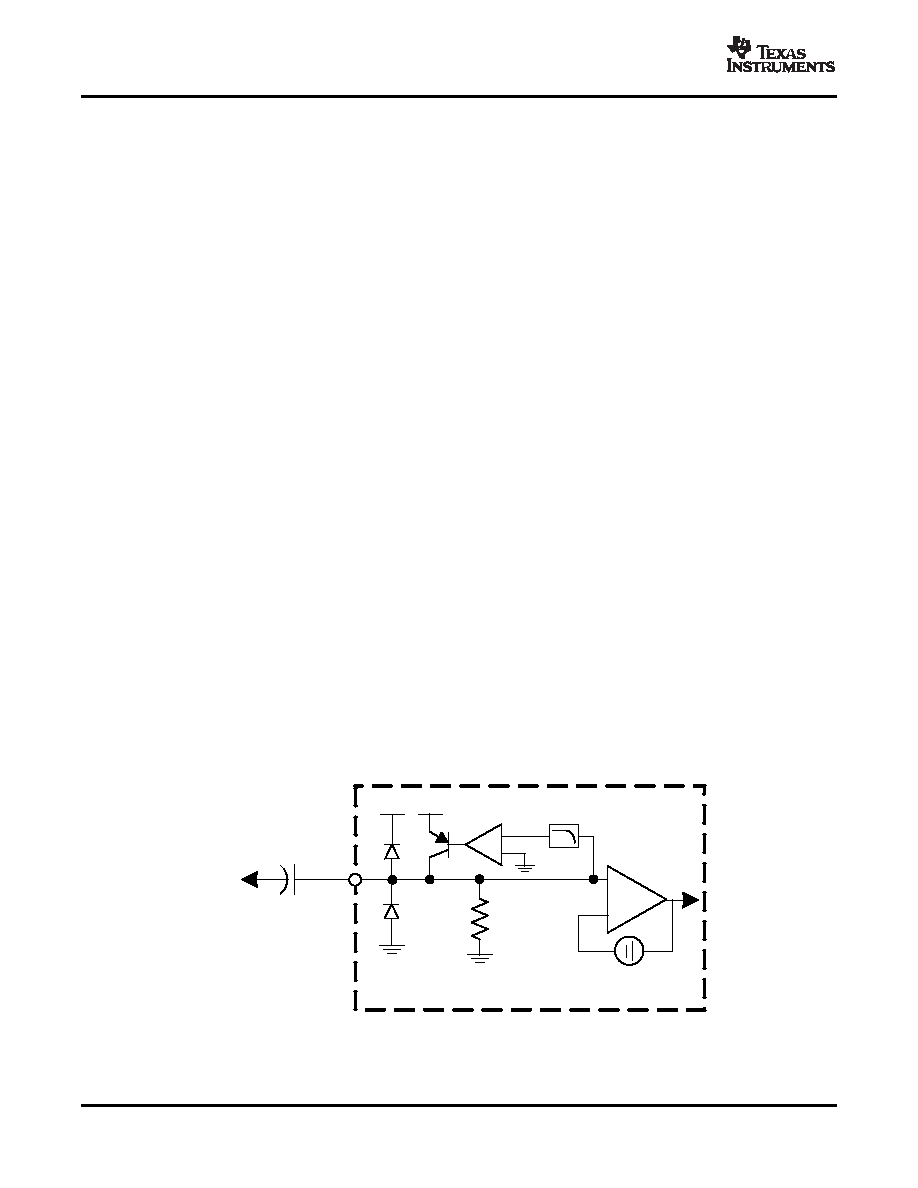- 您現(xiàn)在的位置:買賣IC網(wǎng) > PDF目錄98229 > THS7316DR (TEXAS INSTRUMENTS INC) 3 CHANNEL, VIDEO AMPLIFIER, PDSO8 PDF資料下載
參數(shù)資料
| 型號(hào): | THS7316DR |
| 廠商: | TEXAS INSTRUMENTS INC |
| 元件分類: | 音頻/視頻放大 |
| 英文描述: | 3 CHANNEL, VIDEO AMPLIFIER, PDSO8 |
| 封裝: | GREEN, PLASTIC, MS-012AA, SOIC-8 |
| 文件頁(yè)數(shù): | 6/28頁(yè) |
| 文件大小: | 988K |
| 代理商: | THS7316DR |
第1頁(yè)第2頁(yè)第3頁(yè)第4頁(yè)第5頁(yè)當(dāng)前第6頁(yè)第7頁(yè)第8頁(yè)第9頁(yè)第10頁(yè)第11頁(yè)第12頁(yè)第13頁(yè)第14頁(yè)第15頁(yè)第16頁(yè)第17頁(yè)第18頁(yè)第19頁(yè)第20頁(yè)第21頁(yè)第22頁(yè)第23頁(yè)第24頁(yè)第25頁(yè)第26頁(yè)第27頁(yè)第28頁(yè)

www.ti.com
INPUT MODE OF OPERATION – AC SYNC TIP CLAMP
+
-
+
-
+Vs
STCLPF
Comparator
Input
Pin
Input
Internal
Circuitry
800 kW
0.1 F
m
+Vs
140mVLevel
Shifter
SLOS521A – MARCH 2007 – REVISED JANUARY 2008
Some video DACs or encoders are not referenced to ground but rather to the positive power supply. These
DACs typically only sink current rather than the more traditional current sourcing DAC where the resistor is
referenced to ground. The resulting video signals can be too high of a voltage for a dc-coupled video buffer to
function properly. To account for this scenario the THS7316 incorporates a sync-tip clamp circuit. This function
requires a capacitor (nominally 0.1
F) to be in series with the input. Note, while the term sync-tip-clamp is used
throughout this document, it should be noted that the THS7316 is better termed as a dc-restoration circuit based
on how this function is performed. This circuit is an active clamp circuit and not a passive diode clamp function.
The input to the THS7316 has an internal control loop which sets the lowest input applied voltage to clamp at
ground (0-V). By setting the reference at 0-V, the THS7316 allows a dc-coupled input to also function. Hence,
the STC is considered transparent since it does not operate unless the input signal goes below ground. The
signal then goes through the same 140-mV level shifter resulting in an output voltage low level of 280-mV. If the
input signal tries to go below the 0-V, the internal control loop of the THS7316 will source up to 3-mA of current
to increase the input voltage level on the THS7316 input side of the coupling capacitor. As soon as the voltage
goes above the 0-V level, the loop stops sourcing current and becomes high impedance.
One of the concerns about the sync-tip-clamp level is how the clamp reacts to a sync edge that has
overshoot—common in VCR signals or reflections found in poor PCB layouts. Ideally the STC should not react to
the overshoot voltage of the input signal. Otherwise, this could result in clipping on the rest of the video signal as
it may raise the bias voltage too much.
To help minimize this input signal overshoot problem, the control loop in the THS7316 has an internal low-pass
filter as shown in Figure 29. This filter reduces the response time of the STC circuit. This delay is a function of
how far the voltage is below ground, but in general it is about a 80-ns delay. The effect of this filter is to slow
down the response of the control loop so as not to clamp on the input overshoot voltage, but rather the flat
portion of the sync signal.
As a result of this delay, the sync may have an apparent voltage shift. The amount of shift is dependant upon the
amount of droop in the signal as dictated by the input capacitor and the STC current flow. Because the sync is
primarily for timing purposes with syncing occurring on the edge of the sync signal, this shift is transparent in
most systems.
While this feature may not fully eliminate overshoot issues on the input signal for excessive overshoot and/or
ringing, the STC system should help minimize improper clamping levels. As an additional method to help
minimize this issue, an external capacitor (ex: 10 pF to 47 pF) to ground in parallel with the external termination
resistors can help filter overshoot problems.
It should be noted that this STC system is dynamic and does not rely upon timing in any way. It only depends on
the voltage appearing at the input pin at any given point in time. The STC filtering helps minimize level shift
problems associated with switching noises or very short spikes on the signal line. This helps ensure a very
robust STC system.
Figure 29. Equivalent AC Sync Tip Clamp Input Circuit
When the AC Sync-Tip-Clamp (STC) operation is used, there must also be some finite amount of discharge bias
14
Copyright 2007–2008, Texas Instruments Incorporated
Product Folder Link(s) :THS7316
相關(guān)PDF資料 |
PDF描述 |
|---|---|
| THS7316D | 3 CHANNEL, VIDEO AMPLIFIER, PDSO8 |
| THS7316DG4 | 3 CHANNEL, VIDEO AMPLIFIER, PDSO8 |
| THS7319IZSVR | 3 CHANNEL, VIDEO AMPLIFIER, PBGA9 |
| THS7319IZSVT | 3 CHANNEL, VIDEO AMPLIFIER, PBGA9 |
| THS7360IPWR | VIDEO AMPLIFIER, PDSO20 |
相關(guān)代理商/技術(shù)參數(shù) |
參數(shù)描述 |
|---|---|
| THS7316DRG4 | 功能描述:視頻放大器 3-Ch HDTV Video Amp RoHS:否 制造商:ON Semiconductor 通道數(shù)量:4 電源類型: 工作電源電壓:3.3 V, 5 V 電源電流: 最小工作溫度: 最大工作溫度: 封裝 / 箱體:TSSOP-14 封裝:Reel |
| THS7316EVM | 功能描述:放大器 IC 開發(fā)工具 THS7316 Eval Mod RoHS:否 制造商:International Rectifier 產(chǎn)品:Demonstration Boards 類型:Power Amplifiers 工具用于評(píng)估:IR4302 工作電源電壓:13 V to 23 V |
| THS7318 | 制造商:TI 制造商全稱:Texas Instruments 功能描述:3-Channel Low-Power EDTV/SDTV Video Line Driver With Low-Pass Filters |
| THS7318_07 | 制造商:TI 制造商全稱:Texas Instruments 功能描述:3-Channel Low-Power EDTV/SDTV Video Line Driver With Low-Pass Filters |
| THS7318YZFR | 功能描述:視頻放大器 3-Ch L-P EDTV/SDTV Video Line Driver RoHS:否 制造商:ON Semiconductor 通道數(shù)量:4 電源類型: 工作電源電壓:3.3 V, 5 V 電源電流: 最小工作溫度: 最大工作溫度: 封裝 / 箱體:TSSOP-14 封裝:Reel |
發(fā)布緊急采購(gòu),3分鐘左右您將得到回復(fù)。